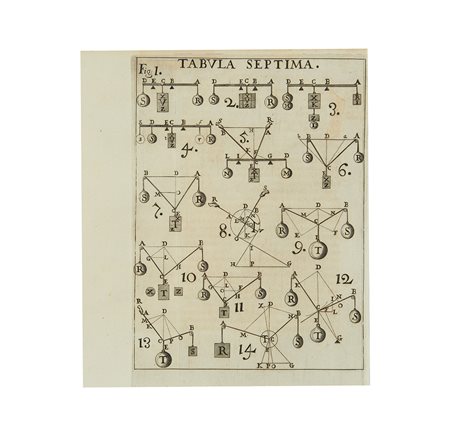 Il Ponte Casa d'Aste - Palazzo Crivelli - Via Pontaccio 12, 20121 Milano
Il Ponte Casa d'Aste - Palazzo Crivelli - Via Pontaccio 12, 20121 Milano
Asta N. 408 - Libri, Manoscritti e Incisioni Sessione Unica - dal lotto 2301 al lotto 2553
martedì 21 novembre 2017 ore 15:30 (UTC +01:00)
BORELLI, Giovanni Alfonso (1608-1679) - De motu animalium. Roma: Angelo...
BORELLI, Giovanni Alfonso (1608-1679) - De motu animalium. Roma: Angelo Bernabò, 1680-1681.
Rara prima edizione dell'opera classica di zoologia del Borelli. Matematico e fisico di formazione, Borelli si interessò alla biomeccanica e alle teorie secondo le quali il corpo è considerato come una macchina i cui movimenti si possono spiegare con le leggi della fisica. In questo importante trattato Borelli presenta l'applicazione della biomeccanica ai movimenti degli arti degli animali basandosi sulle teorie galileiane.
2 volumi, 4to (214 x 154mm). Marca tipografica ai frontespizi, iniziali incise in legno, 18 tavole incise in rame e numerate (alcune lievi bruniture). Pelle coeva, dorso in oro (qualche graffio, perdita al dorso e difetti). Provenienza: Note di provenienza tagliate ai titoli e rimanenze di etichette al dorso. Dibner Heralds of Science 190; Garrison-Morton 762; Grolier/Horblit 13; Heirs of Hippocrates 315; Nissen ZBI 465; Norman 270. (2)
Per questo lotto è disponibile l'Attestato di Libera Circolazione.
BORELLI, Giovanni Alfonso (1608-1679) - De motu animalium. Rome: Angelo Bernabò, 1680-1681.
Rare first edition of Borelli's classic work in theoretical zoology. Trained as a mathematician and physicist, Borelli was one of the founders of the theories of biomechanics, in which the body was conceived as a machine whose movements and phenomena could be explained by the laws of physics. In this important treatise Borelli presents the application of mechanics to the motion of the limbs of animals based largely on Galileo's mechanics. The first portion of this work deals primarily with external motions, produced by the interaction of bones and muscle. The second volume is devoted to internal motions, including circulation, respiration, secretion and nervous activity. Borelli originated the neurogenic theory of the heart's action and first suggested that the circulation resembled a simple hydraulic system. He was the first to insist that the heartbeat was a simple muscular contractions (Garrison-Morton).
2 volumes, 4to (214 x 154mm). Woodcut devices on titles, 18 engraved folding numbered plates. Contemporary calf, gilt spine (chipped and scuffed, without endpapers). Provenance: Ownership inscriptions cut from titles and remains of labels on spine. Dibner Heralds of Science 190; Garrison-Morton 762; Grolier/Horblit 13; Heirs of Hippocrates 315; Nissen ZBI 465; Norman 270. (2)
The lot is accompanied by an export license.

